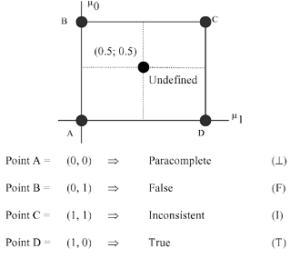
Arquivo para September 25th, 2018
The paraconsistent logic
Kurt Gödel’s paradox, that a complete system is inconsistent was fundamental to a new phase in formal logical principles, and cooperated with the emergence of the computer.
a new phase in formal logical principles, and cooperated with the emergence of the computer.
It was the Peruvian philosopher Francisco Miró Quesada, unknown to many Latin American scholars, who coined the word paraconsistent in 1976.
The Brazilian Newton da Costa who developed this theory has become very important in several areas, including philosophy and Artificial Intelligence. In the figure, the axis to the side that goes from u 0 and u 1 , is called degree of belief, but the truth has points A for consistent and C for inconsistent, having a lot of application to everyday life.
The study applied to semantics mainly explores paradoxes, for example, it can be said that a blind man sees certain circumstances, also the study of different forms of perception and abilities can help the parameters of the deep mind.
We have already stated that neologicism can precisely help AI in this phase of deep intelligence, for example, in the study of natural languages, the language of everyday life.
The idea that A and non-A could exist was inconceivable in Western philosophy, is the principle of the excluded third, which comes from Parmenides and was consolidated in Aristotle. Paraconsistent logics are purposively more “weak,” terms to refer to this break with classical logic, for they solve few valid propositional inferences in the classical sense of logic The logic of paraconsistent languages, however, are more conservative than those of classical counterparts, and this changes Alfred Tarski‘s hierarchy of metalanguage.
The influence on natural language was anticipated in 1984 by Solomon Feferman who stated “… natural language abounds in expressions directly or indirectly self-referential, although seemingly harmless, all of which are excluded from the, because in daily life, in truth we are paraconsistentes.

